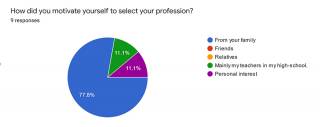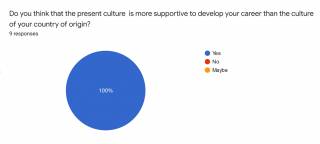Technology is equally important to women and men
‘Technology’ is one of the buzz words of present world. We are living in the era of technology best known as the digital world. The unprecedented growth of technology has become a vital way of advancement and development in the society. People tend to become too dependent on technology, and we cannot avoid realizing its vital role both in our homes and offices. As a result, technology is equally important to women and men, and in order to promote gender equality, women are equally needed to be educated in the fields of technology. However, the overall picture of how women are represented in the technical fields is not satisfactory.
Globally only an estimated 30 percent of researchers in science, technology and innovation are female, while women make up almost half the world population. The situation in the Finnish labor market is not an exception. Immigrant women (hereafter ImmiWomen) face discrimination in the labor market more often than men, due to the gender and ethnic segregation of the Finnish labor market. (The National Institute for Health and Welfare, THL 2017).
ImmiWomen
Most of the ImmiWomen move to another country for family reasons. It has been found that 66% women move to Finland for a family reason (Sutela & Larja 2014). People do not move alone but they bring along their own culture. They practice their own culture in the new settings and sometimes they integrate to the new society in a different role. In particular, ImmiWomen from patriarchal societies follow their cultural norms and values, and they are mostly responsible for doing the household work. There is a high risk of being excluded from integration services, because they are taking care of their children at home and getting little opportunities to participate in the integration processes. Therefore, the immigrant women’s employment rate in the job market is lower (56%) than that of immigrant men (71%), and also of Finnish women (74%) (Nieminen et.al. 2014, 194).
It has been found that the participation of ImmiWomen in the technical field is lower than that of men. There are many reasons behind this, the cultural impact being one of the most important of them. Their own culture is not supportive to choose technology as a profession. As a result, those working in technical sectors face many challenges in overcoming the cultural norms.
Background of my survey
As an expert in the field of women’s empowerment, gender equality, immigrant women and multicultural society, I intended to highlight the cultural challenges i.e., how immigrant women in technical sector face the cultural challenges. This research is a small attempt to promote the interest of young girls in technical sectors and thus reduce gender gap which is one of the main objectives of the NaisTech project.
Keeping this in mind, this empirical research intended to find the impacts of cultural or family background of ImmiWomen working in technical sectors in Finland, i.e. how does cultural or family background influence ImmiWomen working in IT sectors? It was an empirical study, and the data have been collected using a formal questionnaire. The primary data have been collected from nine ImmiWomen working in technical fields. The participants were selected by using purposive sampling and snowball approach. The countries of origin of the participants were Turkey, Bangladesh, Brazil, China and the Philippines. The results of this research are presented below.
Findings of the survey
It is found that family plays a vital role in selecting technical sector as a profession, for example, 7 out of 9 participants claimed that their family was the main source of their motivation to select this profession.

Participants mentioned that there were challenges for women to choose IT as a profession in their original country. Primarily men were preferred in this field, they could work longer hours and travel freely compared to women. As a result, IT engineering is mainly dominated by men, and being a minority, women always have to face obstacles and challenges. It is necessary to spend more quality time in the IT companies or organizations, in comparison to other fields, but that is difficult for women who are maintaining household work. So people think IT jobs are not for girls.
“In my country of origin, my profession has always been a profession dominated by men. This fact makes the professional path for women harder. My society strongly believes that girls must stay at home and take care of their families. In addition, lack of technical resources and funding at educational institutions are also big issues of selecting IT as a profession for girls”.
The participants claimed that lack of social support is also a vital cause for girls to build their career in technical sector, and society is not accustomed to see too many women in the tech field. They mentioned that family plays vital role to overcome those challenges. As some of them mentioned:
“Fortunately, I didn’t have to face such obstacles. My family was always supportive and enthusiastic about my skills and choices. Also I was not afraid to stand out in a male dominant world”.
“My parents were determined to encourage and support their children in gaining access to good education. They made sacrifices to make sure we stayed in school and exposed us to any technical resources that they were able to afford”.
The participants also claimed that Finnish culture is more supportive in developing their career in technical sector than the culture in the country of their origin. They are satisfied with their work environment.
“In my current workplace, I’m not treated as a woman, rather as a co-worker. My opinion and contribution is valued equally. Even in Finland, I’ve seen that it is not common for girls to be in the technical field. I’ve been working in teams of at least 10 members, where I’m the only female programmer. Still I have not faced any discrimination. I’ve been fortunate enough to find supportive mentors. Also in my current company, most of the product managers are female and that is quite inspiring”.

The participants mentioned that girls/women need more support or motivation to work in technical fields, not only from their family but also from society. They need more encouragement to boost the confidence that they can survive in a technical field, especially if they have a passion and personal interest in the field.
“I think girls need to be motivated to be in STEM more. There is a misconception that girls are not smart enough to excel in these fields. They just need to be more curious, pro-active and confident to succeed. Finding out a perfect mentor is also a key factor. A good mentor can help to nourish the skills and help to succeed further and family should play a strong role as a mentor first”.
Finally, it can be said that the family plays a vital role in selecting a technical sector as a profession for their girls despite other cultural backdrops. Therefore, the family should come up first to motivate their girls to select technical sectors as their profession.
Acknowledgements
I am very thankful to the participants for their valuable time, support and opinions for this research. I also found that the participants were very pleased to take part in this research, and they believed that this survey might encourage ImmiWomen in technical sectors.
This research is a part of ‘NaisTech’ project of Tampere University of Applied Sciences, and it intends to increase women’s interest in the fields of technology in Finland with special reference to the ImmiWomen.
References
The links below were accessed on 24 May 2022.
Nieminen, T., Sutela, H., & Hannula, U. (2015). Ulkomaista syntyperää olevien työ ja hyvinvointi Suomessa 2014. [Work and wellbeing of foreigners in Finland 2014]. Työterveyslaitos, Terveyden ja hyvinvoinnin laitos, Tilastokeskus, 2015. https://www.doria.fi/bitstream/handle/10024/184506/yyti_uso_201500_2015_16163_net.pdf
Siukola, R., Soronen, S., Teräsaho, M. (2017). Oikeusasiat ja turvallisuus. [Legal matters and safety]. National Institute for Health and Welfare (THL). Discussion paper 16/2017. Helsinki, Finland 2017. https://urn.fi/URN:ISBN:978-952-302-847-0.
Sutela H & Larja L. (2014) Yli puolet Suomen ulkomaalaistaustaisista muuttanut maahan perhesyistä. Ulkomaista syntyperää olevien työ ja hyvinvointi tutkimus 2014 [verkkojulkaisu]. 15.10.2015. Tilastokeskus. https://www.stat.fi/tup/maahanmuutto/art_2015-10-15_001.html
The National Institute for Health and Welfare (THL) (2017). Migration and Cultural Diversity. https://thl.fi/en/web/migration-and-cultural-diversity/integration-and-inclusion/gender-equality
Author: Nasrin Jahan Jinia. Lecturer for Social Services and Health Care at Tampere University of Applied Sciences (TAMK).
Photo: Nasrin Jahan Jinia
Published: 24 May 2022






Kommentit